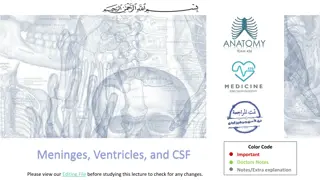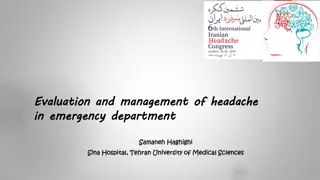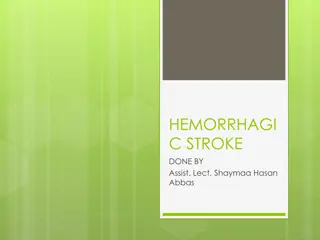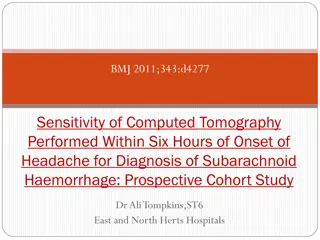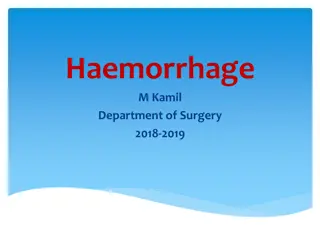Combatting Postpartum Haemorrhage: Roadmap and Call-to-Action
Postpartum haemorrhage (PPH) is a significant global health concern, particularly affecting low- and middle-income countries. The need for a comprehensive roadmap and call-to-action arises from public health needs, innovation deficits, inconsistent guidance, implementation barriers, and the high mat
2 views • 17 slides
Understanding Antepartum Haemorrhage and Placenta Praevia
Antepartum haemorrhage, especially in cases of placenta praevia, can present challenges in pregnancy. This condition, where the placenta covers or is near the cervix, requires careful monitoring and may necessitate interventions like ultrasound scans and potential hospital admissions. Risk factors f
7 views • 15 slides
Understanding the Meninges, Ventricles, and CSF in the Central Nervous System
The lecture covers the cerebral and spinal meninges, emphasizing the dura, arachnoid, and pia mater layers. It explores the significance of the subarachnoid space and the ventricular system in the CNS, including CSF formation, circulation, and clinical implications.
0 views • 18 slides
Evaluation and Management of Headache in the Emergency Department
Headaches unrelated to trauma account for 2% of emergency department visits. It is crucial to differentiate between patients with life-threatening headaches and those with benign primary headaches. History and physical examination play a vital role in assessing and diagnosing patients with high-risk
0 views • 33 slides
Treatment Strategies for Hemorrhagic Stroke: Goals and Management
Short-term goals for treating hemorrhagic stroke involve rapid neurointensive care to maintain adequate oxygenation, breathing, and circulation, along with managing increased intracranial pressure and blood pressure. Long-term management focuses on preventing complications, recurrent bleeding, delay
11 views • 9 slides
Lumbar Puncture: Indications, Contraindications, and Post-procedure Considerations
Lumbar puncture is a medical procedure involving the insertion of a needle into the spinal subarachnoid space to collect cerebrospinal fluid for diagnostic or therapeutic purposes. Indications for performing a lumbar puncture include suspicion of meningitis, subarachnoid hemorrhage, CNS diseases lik
0 views • 17 slides
Sensitivity of Early CT in Diagnosing Subarachnoid Haemorrhage
This prospective cohort study aimed to assess the sensitivity of early computed tomography (CT) in identifying subarachnoid haemorrhage (SAH) in patients with acute headache. Over 9 years, 5424 patients were evaluated, with 240 (7.7%) confirmed to have SAH. Sensitivity of CT within 6 hours of headac
0 views • 16 slides
Managing Hemodynamic Changes After Subarachnoid Block in Obstetric Patients: Exploring Zofran's Potential
Explore the potential of using Zofran to address hypotension and bradycardia following subarachnoid block in obstetric patients. The discussion covers physiological effects, reflexes, serotonin receptors, Zofran pharmacology, literature review on its efficacy, dosing recommendations, and concerns ab
0 views • 29 slides
Understanding Haemorrhage and Its Impact in Surgery
Haemorrhage in surgery is a critical phenomenon leading to hypovolaemic shock, trauma-induced coagulopathy, and other complications. It involves ongoing bleeding, hypoperfusion, acidosis, and hypothermia, exacerbating the condition. Classification includes revealed and concealed haemorrhage, with pr
0 views • 33 slides


